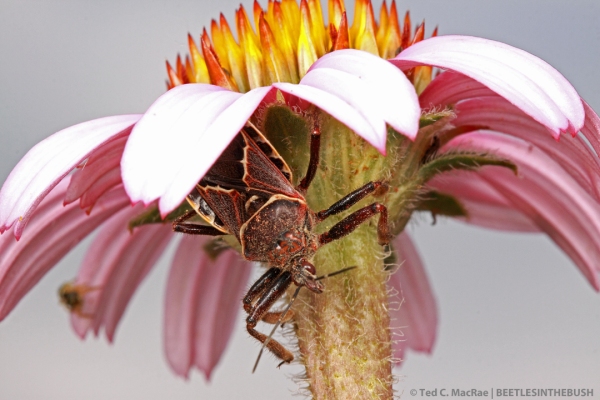
Apiomerus spissipes? on coneflower (Echinacea sp.) | Gloss Mountain State Park, Major Co., Oklahoma
While looking for longhorned beetles on prickly pear cactus (Opuntia macrorhiza) at Gloss Mountains State Park, I saw a coneflower that didn’t look quite right—there was nothing on the top, but there seemed to be something on the underside. I knelt down cautiously and peered underneath the blossom to find this bee assassin (family Reduviidae, genus Apiomerus) lurking under the petals. As a collector with eyes always looking for signs of insects, I’ve trained myself to look for both the obvious and the non-obvious, yet this brightly colored insect still almost completely escaped my notice. I can imagine that a bee with little room in its mind for anything but collecting pollen would be easy pickings for such a stealthy predator.

The coloration of this individual seems to best match specimens representing the species Apiomerus spissipes, which ranges broadly and abundantly across the Great Plains (Berniker et al. 2011). The location of Gloss Mountain State Park in western Oklahoma places it almost smack in the middle of the recorded distribution for this species, which is largely replaced further east by the closely related but generally darker A. crassipes. Interestingly, very few Oklahoma specimens were available for examination by Berniker and colleagues during their study, a fact that once again demonstrates the need for continued collecting in even “well-collected” states like Oklahoma.
REFERENCE:
Berniker, l., S. Szerlip, D. Forero & C. Weirauch. 2011. Revision of the crassipes and pictipes species groups of Apiomerus Hahn (Hemiptera: Reduviidae: Harpactorinae). Zootaxa 2949:1–113.
Copyright © Ted C. MacRae 2013
Interesting – my colleague Matthias Buck recently picked up what seems to be Apiomerus spissipes in southern Alberta – and then someone posted a picture of another from Medicine Hat. This bug seems to be having a good summer.
I think the relatively mild and moist summer – especially across the normally hot and dry Great Plains – has been good for many insects. I had one of the best collecting trips ever this June, no doubt because of the good rains.
During my recent trip to Williamson Valley, AZ I saw what I thought was a pair of Batyle ignicollis doing the dance of love on Blueweed flowers. I started to make a hand grab for them and then something told my hand to stop. I took a second and then third look and finally decided it was a Bee Assassin sucking the life out of a male Batyle. I managed to take the male bycid away from the assassin and went looking for more. Later when I went back she had another Batyle in her grasp, this time a female. I’m sure she was saying get your own meal! She was clearly a better hunter than I.
My first lesson with assassin bugs was of the worst kind – I was making a collection for my first entomology course and saw one fly inside the building where I was working. Without thinking I grabbed it – then just as quickly let it go when I felt the sharp, stabbing pain in my finger.
Funny you should mention Batyle ignicollis – I’ve only ever collected the odd specimen here and there but ran into a bunch of them at a couple of spots during the June Oklahoma trip. Pics to come…
My lesson came when I was a teenager, when my mother took a friend and I on a collecting trip to Arizona (I think she did a lot of reading on that trip!). I believe it was in Wickenburg, where I was poking about the lights looking for longhorns and scarabs. Thinking I was seeing an interesting longhorn crawling along the ground–the lighting was poor–I grabbed it. Then I screamed…and continued to howl for quite some time. My mom panicked at first when she heard me. It was not a cerambycid…it was a reduviid, a western corsair! They have a particularly nasty bite.
That’s funny (not the bite, but the species), as my lesson came with the closely related black corsair (Melanolestes picipes).
Yes, it was a pain that just did not stop!